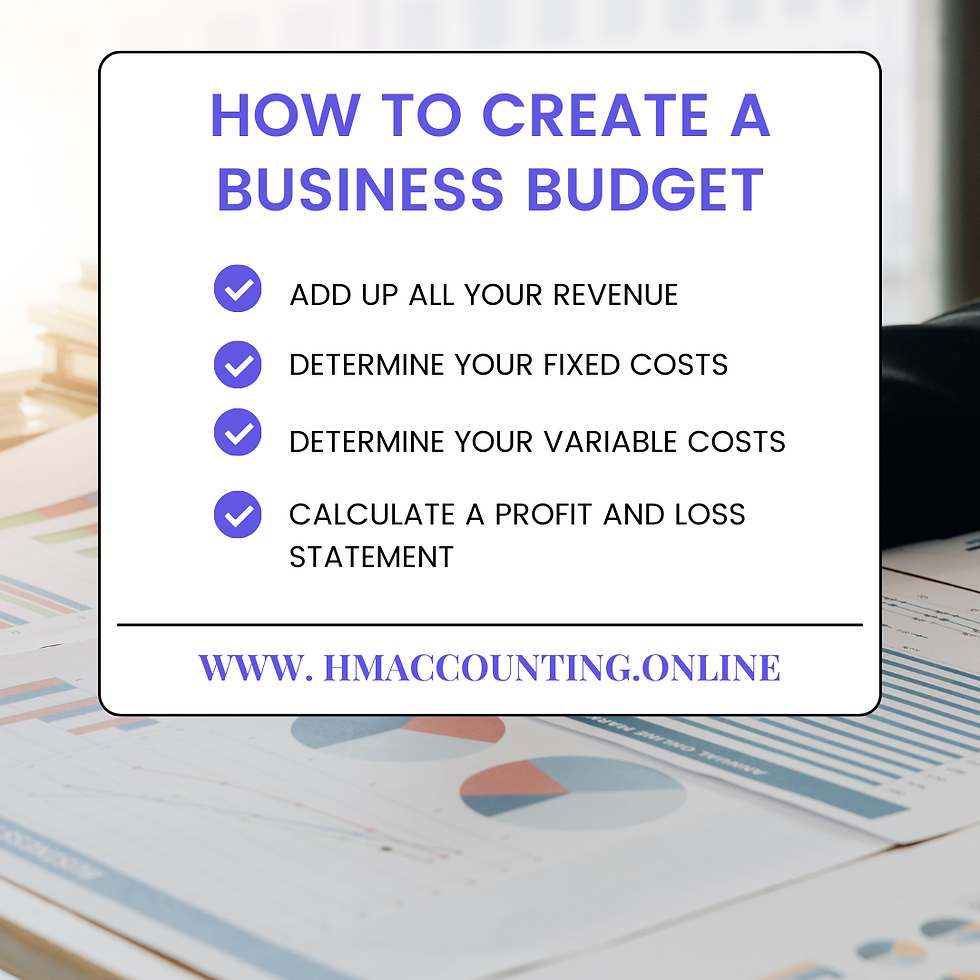Uncomplicating Business Budgets: A Simple 4-Step Guide for Entrepreneurs
- Humairaa Moola

- Feb 19, 2024
- 5 min read
For many of us, the prospect of simply creating a budget for your business can seem like a daunting task (and is perhaps actually more daunting than the act of budgeting itself).
However, the benefits of a well-crafted business budget are invaluable, providing clarity, control, and long-term success. A business budget can ultimately take a lot of the fear out of our finances. In this blog post, we'll break down the process into four simple steps, making business budgeting less intimidating and more manageable.
But First, Do You Really Need a Business Budget?
Just like a personal budget, it helps you make intentional financial decisions, reach goals efficiently, pay off debt faster and live within your means. For businesses, it goes a step further by paving the way for long-term success which means more security and money in your pocket for years (or decades) to come.
A business budget helps to clarify:
How much money you expect to earn in a given timeframe
Whether your cash flow is adequately covering your business’ monthly expenses
When you have leftover money that you can reinvest in the business
When months are slow for your business, so you can prepare, make necessary changes, and stay out of debt
How much you need to increase your revenue or cut expenses to become more profitable
Knowing these things allows you to optimize your systems and plans to invest in your business when times are good and create a safety net for when times are tight. This clarity helps you to be intentional about your business finances and increases your ability to grow and thrive in a sustainable way.
Follow the steps below and you’ll have created a business budget that will benefit your finances for years to come (as long as you stick with it).
STEP 1: Count up all your Revenue
Your first step is to determine how much revenue your business produces. Calculate your monthly income from your business for the past six months to a year (or more, if possible). As you go through this process, make sure you’re calculating the business revenue rather than the profits. Revenue is every source of income that comes into your business before subtracting taxes or expenses.
Depending on how long you’ve been in business, it can be most beneficial to calculate monthly revenue for at least the past year. Calculating your monthly revenue for a longer timeframe aids in identifying seasonal fluctuations, allowing better preparation for slow periods and more accurate future forecasts.
For example, some businesses experience a seasonal downturn after the holidays or during the holidays. The more information you have from the past, the more accurate your forecasts for the future will be, and the more time you will have to prepare for these slow periods next year.
STEP 2: Determine Your Fixed Costs
Next, it’s time to identify your fixed monthly costs. These are recurring expenses independent of your business's production level. For example, fixed costs might include:
Rent on your office or store space
Website hosting fee
Subscription fees
Insurance
You might notice that some fixed costs are annual and some are monthly. To stay consistent, divide the annual costs by 12 so everything is calculated monthly. Add each item together so you know how much your fixed costs are per month.
STEP 3: Determine Your Variable Costs
The third step is to determine your variable costs. Variable costs are just that – they’re variable! They don’t have a fixed price, and they fluctuate depending on your business performance, activities, and uses of other goods and services. Variable costs might include:
Utility payments
Office supplies
Wages
Consumables
As with revenue, the more months of variable expenses you can gather, the faster you’ll be able to spot patterns and better prepare for when those variable expenses creep higher during the year. This knowledge allows you to make more accurate spending projections so you can budget appropriately.
It’s absolutely okay if your budget isn’t perfect when you’re starting out. Do what you can to gather as much data about variable costs as possible. As long as you stick to your budgeting habit going forward, you’ll be able to spot patterns more easily over time.
STEP 4: CALCULATE A PROFIT AND LOSS STATEMENT
Finally, it’s time to bring all this data together and create your profit and loss statement. While a profit and loss statement might sound scary, you’ve already done the hard work. You simply have to add all your monthly expenses (your fixed costs and variable costs) and then subtract those expenses from the monthly revenue you calculated in Step 1.
That’s all there is to it! Do this for each month you have data so that you have a profit and loss statement for January, February, March, and so on.
Hopefully, the number you get for each month is a positive one. But if it’s not, at least now you know! You can take the steps needed to cut back on your expenses or work to increase your profitability. And if your profits are significantly higher than your expenses but you’re not doing anything with that money, now you know you have some options with the profits. You can take more home, build your reserves or reinvest in the business!
You’ll receive the greatest benefits of budgeting if you budget consistently. Once you’ve done the legwork, all you have to do is keep tracking your revenue and your expenses. The longer you budget, the more data you’ll have to make more accurate projections, save for your business investment goals, and grow your business to achieve the success you’ve always dreamed of.
Creating a business budget doesn't have to be a nerve-wracking experience. By following these four simple steps and maintaining consistency, you'll gain control over your business finances, paving the way for sustained success and financial confidence. Remember, the journey to financial clarity is an ongoing process, and every step counts toward a more prosperous future for your business.
HOW HM ACCOUNTING CAN HELP YOU & YOUR BUSINESS
Creating a business budget is a great way to get clarity and take control of your business finances. But sometimes, you need just a little extra help when it comes to managing your cash flow, implementing sound systems for maximum efficiency, and learning how to pay yourself more consistently.
The team at HM Accounting is here to help. We specialize in helping small business owners and entrepreneurs maximize their profits, master their cash flow, and build confidence with their finances. To see how we can help you and your business, email me at info@hmaccounting.online or simply schedule a free 30-minute Discovery Call on my calender
Love staying updated on the latest trends, insights, and exclusive content? Don't miss a beat – subscribe to our newsletter today!
By subscribing, you'll be the first to know about:
✨ Exciting new blog posts
🚀 Special promotions and offers
🌐 Industry insights and trends
🎁 Exclusive content just for our subscribers
Join our growing community and never miss a moment - SUBSCRIBE HERE





Comments